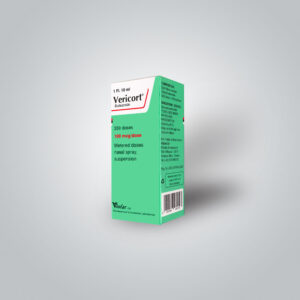 VERICORT nasal spray, suspension
VERICORT nasal spray, suspension
VERICORT®
International non-patented name: Budesonide
Composition
Active substance: 1 ml of suspension contains 1 mg or 2 mg of budesonide. One spray contains 100 mcg of budesonide.
Excipients: anhydrous glucose, microcrystalline cellulose, sodium carboxymethyl cellulose, sodium carmellose, potassium sorbate, polysorbent 80, disodium edetate, hydrochloric acid, purified water.
Description
Colorless liquid.
Pharmacotherapeutic group
Glucocorticosteroids
ATC : R01AD05.
Pharmacological characteristics
Pharmacodynamics
Budesonide is a synthetic glucocorticosteroid (GCS) for inhalation, with almost no systemic effects. Budesonide has anti-inflammatory, anti-allergic and immunosuppressive effects. It increases the production of lipocortin, an inhibitor of A3-phospholipase, slows down the release of arachidonic acid, affects the synthesis of arachidonic acid metabolism products – peroxides and prostaglandins. Budesonide prevents the accumulation of neutrophils, reduces the formation of inflammatory exudate and the production of cytokines, slows down the migration of macrophages, reduces infiltration, does not allow hemotaxis to occur and slows down the release of inflammatory mediators. reduces the swelling of the mucous membrane of the bronchi, mucus production, sputum formation and hyperactivity of the respiratory tract. Increases mucociliary transport.
The therapeutic effect of the drug begins a few hours after use. The maximum therapeutic effect is achieved 1-2 weeks after starting the treatment. With regular use, budesonide in patients with bronchial asthma reduces chronic inflammation in the lungs and thus improves lung function, the course of bronchial asthma, reduces hyperactivity of the bronchi and prevents exacerbation of the disease..
Pharmacokinetics
Absorb
Budesonide is quickly and completely absorbed after inhalation, at which time the maximum concentration in the blood plasma is reached 30 minutes after the start of inhalation. After inhalation of budesonide, the concentration of the drug in the mucous membrane of the oropharynx is 73%.
Distribution
Its combination with plasma proteins is 88%
Metabolism
After absorption, budesonide undergoes intensive biotransformation (more than 90%) in the liver and increases the activity of glucocorticosteroids, forming metabolites. The glucocorticosteroid activity of the main metabolites of 6-hydroxy-budesonide and 16-hydroxyprednisolone is less than 1% of the glucocorticosteroid activity of budesonide. Budesonide has a high systemic clearance (approximately 1.2 L/min) and a short elimination half-life (2.8 hours). Budesonide is mainly metabolized by the enzyme CYP3A4.
Exclusion
10% is excreted from the intestines in the form of metabolites, 70% is excreted through the kidneys.
The pharmacokinetics of budesonide is proportional to the dose of the drug.
Pharmacokinetics in special clinical situations
Blood plasma concentration of budesonide increases in patients with liver disease
Instructions for use
Seasonal, year-round allergic rhinitis and non-allergic rhinitis.
Treatment and prevention of recurrence of nasal polyps.
Contraindications
High individual sensitivity to any of the components of the drug. Active form of tuberculosis.
Special instructions and precautions
Caution should be exercised when using Verikort in patients with fungal or viral nasal infections, as well as untreated systemic bacterial, fungal or viral infections and herpes ophthalmia.
In order to avoid unwanted effects that are likely to occur during treatment with corticosteroids in patients suffering from tuberculosis, the benefit and risk ratio of treatment should be properly assessed.
Due to their inhibitory effect, nasal corticosteroids can be used only after complete resolution of symptoms during healing of skin lesions, nasal septum ulcers, surgical interventions or nasal trauma.
If any symptoms of local irritation are noted after topical corticosteroid use, treatment should be stopped immediately.
In patients treated with oral corticosteroids, during the transition to the use of Verikort nasal spray, special control is required to prevent any imbalance in the hypothalamo-pituitary-adrenal system. For this, the use of Verikort nasal spray should be combined with a gradual reduction in the dose of oral corticosteroids.
Intraocular pressure, glaucoma, or cataracts may develop after inhaled or intranasal corticosteroid therapy.
For sports activities: in the absence of therapeutic necessity, the use of the drug can lead to a positive result in an anti-doping test.
The medicine should be kept out of the reach of children.
Patients with diabetes, liver problems, nosebleeds, eye infections should use the drug with caution.
If several corticosteroid preparations are used, it is necessary to inform the doctor about this.
Interaction with other drugs
Using Cimetidine at the same time as Budesonide can lead to slight changes in its pharmacokinetics.
Use during pregnancy and lactation
Budesonide should not be used during pregnancy unless clearly indicated. Praparat use is not recommended during the first three months of pregnancy.
There is no information on the transfer of budesonide to breast milk during lactation.
Only the doctor decides on the use of the drug during pregnancy and lactation.
Method of use and dosage
The dosage of Vericort and the duration of treatment should be determined individually by the doctor. Verikort drug is not intended for children under 6 years of age.
1 dose (100 mcg) of Verikort preparation corresponds to 1 spray.
Doses are selected individually, depending on the severity of the disease and the patient’s response.
Adults and children over 12 years of age: 100-200 mcg budesonide 1-2 times a day.
Children 6-12 years old: 200 mcg budesonide 1-2 times a day.
In children, the drug should be used only under the supervision of adults.
Verikort drug has an anti-inflammatory effect, so it should be taken regularly even after the patient’s condition improves. As a rule, the drug Verikort is prescribed for a long-term and individually determined course of treatment. Sometimes, when there is a large amount of secretion in the bronchi, it becomes difficult for the drug to enter the inflammatory zone. In such cases, it is recommended to conduct a short course of treatment with GKS for oral administration. Inhalations are carried out after reducing the dose of oral CS.
If the patient receives oral oral contraceptives, he is transferred to treatment with Verikort in the stable phase of the disease. They are gradually canceling GKS. For 7-10 days, it is necessary to combine oral intake of QKS in a selected dose and inhalations with Verikort in a high dose (up to 1600 mcg per day). Then the dose of GKS is gradually reduced to 2.5 mg of prednisolone every 1-2 weeks.
Instructions for use
Before each use
Before use, it is necessary to shake the bottle well. remove the protective cap of the nasal spray. Hold the bottle vertically away from your face and test the spray several times.
Before using the spray, the nasal area should be carefully cleaned. Pinch the nostril where the drug is not injected with your finger, and insert the tip of the applicator into the free nostril. Hold the bottle straight and tilt your head slightly back.
Remove the applicator of the vial from the nasal area and hold it in the indicated direction until the medicine is completely distributed in the nose.
Inject the drug into the other nostril in the same way.
Close the protective cap of the vial after use.
Warning
The vial is usable within three months after opening. If the tip of the vial is caught, it should be separated from the vial and kept in hot water for a few minutes. Do not use sharp tools to clean the tip.
Side effects
In some cases, drying of the nasal mucus or sneezing may be observed after using VERIKORT nasal spray. Slight bleeding and itching of the nose may occur.
Endocrine system: rarely – inhibition of the function of the cortex of the adrenal glands, Cushing’s syndrome, hypercorticism, growth retardation in children and adolescents.
To the organ of vision: not known – cataract, glaucoma.
Allergic reactions: not known – hypersensitivity reactions, rash, urticaria, angioneurotic edema, itching.
To the CNS: abnormal behavior, including depression (occurring in children).
To the musculoskeletal system: a decrease in the mineral density of bone tissue.
To the respiratory system: very often – cough; rarely – paradoxical bronchospasm, candidiasis of the mucous membrane of the oral cavity and larynx, irritation of the pharynx, dysphonia, which disappears after stopping treatment with budesonide or reducing the dose of the drug.
Common: nasal dryness, sneezing, nasal irritation, epistaxis, muscle spasm, epitaxy, nasal mucosal ulcers, voice change, blurred vision, skin bruising.
Overdose
It is important to take the medicine in the dosage indicated on the package insert or prescribed by the doctor. It should be used only in the dose recommended by the doctor, using less or more than the prescribed dose may cause exacerbation of symptoms.
In rare cases, hypersensitivity and dermatitis may occur immediately after intranasal use of Verikort.
Packing form
VERIKORT 100 mcg nasal spray, suspension.
10 ml of suspension in a vial. 10 ml of suspension contains 10 mg of budesonide, which is equivalent to a total of 200 sprays. 1 spray contains a dose of 100 μg. 1 vial is packed in a cardboard box with an insert.
Store condition
It should be stored at a temperature not higher than 25ºС, protected from light and out of the reach of children. The drug can be used within three months from the day of opening.
The shelf life is indicated on the packaging.
By prescription
Manufacturer
VİOFAR LTD,
Ethnikis Antistaseos & 76A Trifilias str. 13671, Acharnai, Attiki, Greece.
